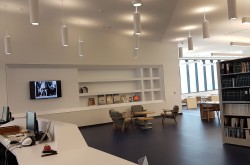Expédition dans le détroit d’Hudson : regarder au-delà de la provenance
À l’occasion de la Semaine de sensibilisation aux archives (du 2 au 8 août), Ingenium met en valeur quelques joyaux de sa collection numérique.
Dans le monde des archives et des musées, l’histoire est souvent racontée par la lorgnette de
Raconter l’histoire d’un document de cette façon peut nous permettre d’en savoir beaucoup, mais peut aussi laisser muets certains faits liés à l’ouvrage. Permettez-moi de mieux m’expliquer en prenant l’exemple d’une des collections contenues dans les Archives numériques.
In 1927, the Hudson Strait Expedition set out on a mission to determine if the Hudson Strait could be used as an economical way of shipping grain to Europe. The expedition conducted aerial surveys, reported on weather patterns, and sought to find the best spot to end the extension of the railway line connecting to the proposed port. The members took photographs of their journey as part of their work; the resulting photograph albums that we have at the Canada Aviation and Space Museum have been catalogued as the “Hudson Strait Expedition fonds.” Fonds is the term we use in archives to describe records created by one creator. So, already we’ve made a decision to consider the “expedition” and its members as one creator.
Beyond the visual information in the photographs themselves, the only information in the fonds comes from the titles that were written under each image in the albums. Further understanding of the mission needs to come from reading the published report of the expedition (available in our library) or other sources, such as the National Film Board documentary, The Aviators of Hudson Strait.
But then if you have to look elsewhere to complete the story from the perspective of the expedition, why not also invest time and resources in telling some other stories? There are also individual life stories that could be told for each expedition member, including Inuit guides and camp helpers who are not named in the albums, report, or film. Other people – not on the expedition – were photographed as they conducted their daily lives. From the point of view of the expedition, they were sights or objects to be documented as part of the voyage.
As we work to add further information to the catalogue records in our Digital Archives, we hope to not stop at provenance – the creator’s point of view – by adding other keywords and relevant information. These archives live beyond the present purpose for which they were created, and could be made to tell more history where the story of provenance stops short.



























![Un bloc de photographies montrant quelques-unes des personnes impliquées dans le bombardement des bélugas de l’estuaire et du golfe du fleuve Saint-Laurent. Anon., « La chasse aux marsouins [sic]. » Le Devoir, 15 août 1929, 6.](/sites/default/files/styles/thumbnail_7/public/2024-09/Le%20Devoir%2015%20aout%201929%20page%206.jpg?h=584f1d27&itok=TppdLItg)






